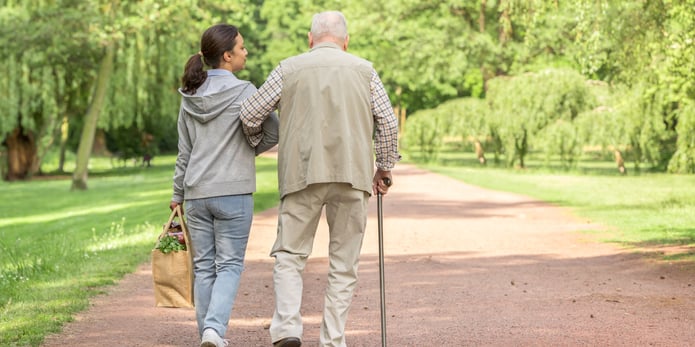
We all know that sitting for most of the day isn’t good for you. But if someone you love suffers from dementia, you might be struggling to find ways to get them moving.
In this blog, we share tips for gradually increasing physical activity in aging adults with dementia as well as ideas for specific exercises and activities you can try with your loved one. But before you put on your tennis shoes, it helps to understand why physical activity becomes increasingly difficult for those living with dementia.
Why Dementia Makes Exercise Challenging
Dementia is a progressive brain disease, which means that symptoms start out slowly and gradually get worse. Over time, dementia leads to changes in sensory and motor systems, which affects balance and gait. So if your loved one’s walking speed is slowing, it might indicate that they’re experiencing changes in cognitive processing.
Dementia also impacts judgment and visual-spatial perception. For example, your loved one might trip over a rug that’s never been a trip hazard in the past because it’s more difficult for them to recognize and avoid hazards. As people with dementia begin to forget more and more, it becomes increasingly challenging to complete everyday tasks, even ones that used to be so familiar. For instance, your loved one might struggle to start an activity on their own or carry out activities in the proper sequence.
7 Tips for Increasing Physical Activity
If you’re worried that physical activity might result in an injury or cause pain or if you’re unsure of what types of activities are best for people with dementia, you’re not alone. Many family caregivers are in this same boat.
Here are some tips for getting started:
- Establish reasonable goals, especially if your loved one is relatively inactive. Start slowly and increase gradually to prevent injury and have better results. For example, start out with episodes of activity of less than 10 minutes twice a day.
- Be aware of physical difficulties, such as tiring quickly, impaired vision, or limited hearing, and modify activities to your loved one’s abilities.
- Focus on making regular exercise a pleasant activity. Stick with activities your loved one has always enjoyed, and don’t refer to it as exercise. Treat it as just another regular task in their daily routine.
- Use simple, easy-to-follow directions. Break complex behaviors into small steps, and add the next step as each step is mastered.
- Offer visual cues and reminders to prompt your loved one. For example, demonstrate the movements, slow the pace as needed, and provide help when needed.
- Remember to have fun with it! Focus not on what’s lost but on what’s left and concentrate on what can be done rather than what can’t.
- Keep a log and celebrate successes. Write down your loved one’s physical activities in a diary and reward yourselves for accomplishments.
7 Creative Ways to Incorporate Physical Activity
If your loved one hasn’t exercised regularly in the past, it can be especially difficult — though absolutely not impossible — to motivate them to engage in physical activity. Fortunately, for people with memory loss, physical activity doesn’t have to be regimented exercise.
For people in the early to middle stages of dementia, it might include stretching, dancing, gardening, walking, or any other variety of activities they might enjoy. For those in the later stages of dementia, staying mobile can be as simple as changing chairs when having a drink or a meal.
Here are seven ways to incorporate physical activity into your loved one’s day.
Walking
Walking is one of the best ways to increase physical activity because distance and time spent can be varied to suit fitness levels. Go on a walk with your loved one through the park or courtyard. Take in the scenery and focus on how the sun or breeze feels.
Slow marching is a good exercise for the hips, knees, and ankles and for better balance, too. Your loved one can stay behind a chair to hold on for support if they prefer.
Dancing
Dancing is great because it doesn’t feel like exercise. Play your loved one’s favorite music and invite them to dance and shuffle around a bit with you. They will not only benefit from the activity but also from the music.
Moving While Sitting
If your loved one has limited mobility, encourage them to move while sitting down. Try sitting across from them, playing light music, and moving your arms, head, shoulders, legs, and feet. You might even try tossing some scarves or small balls back and forth with your loved one. Be creative! It’ll add to the fun.
Doing Household Chores
It might not sound like fun to you, but if your loved one used to take pleasure in organizational tasks or cleaning the house, activities around the home can help them feel active and engaged and can enhance their self-esteem because it shows they can still manage useful tasks. For example, staying balanced in a standing position — such as when washing dishes — helps improve balance and posture. Other household chores, such as folding laundry or organizing a messy drawer can all help a person feel a sense of accomplishment.
Practicing Tai Chi
Tai chi combines simple physical movements and meditation, with the aim of improving balance and health. The movements concentrate on a series of integrated exercises. These forms of exercise focus on balance and stability, which are important in staying agile and may reduce the risk of falls.
Gardening
Gardening is a great physical activity for people with dementia because it offers an opportunity to get some fresh air and exercise. The activity level can be varied to suit someone’s abilities. For example, weeding and pruning require less exertion than raking. These activities can help strengthen the body’s muscles and improve breathing.
Participating in Sit and Be Fit
Renowned dementia expert Teepa Snow recommends the Sit and Be Fit program for anyone needing slow gentle movement. An award-winning exercise series, each chair exercise program is carefully researched and designed by a team of physical therapists, doctors, nurses, and exercise specialists. Programs focus on exercises that make everyday activities easier to perform, including core strengthening, balance work, stretching, and relaxation.
This is by no means an exhaustive list. Any form of exercise can bring benefits.
To create a daily physical activity plan for your loved one with memory loss, download our Physical Activity Planner for Memory Loss. It includes a planner, where you can brainstorm activities you can do with your loved one to keep them moving, as well as a Daily Activity Journal to keep track of your loved one’s physical activity and their responses to the various activities you planned throughout the day. With some creativity and patience, you can create a variety of activities to keep your loved one moving.





